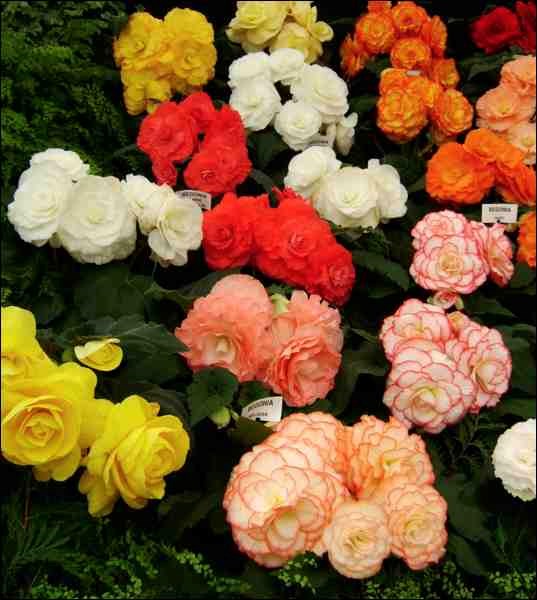When it comes to a shady or north facing garden bed, there are few annuals that outshine tuberous begonias (Begonia x tuberhybrida) with their bright yellow, pink, scarlet, orange or white flowers. Leaf colour ranges from light to very dark green. You'd think the dark green would make the plants disappear into the shade. But to the contrary, they really help to set off the brightly coloured blooms. Flower form varies from single to double flowers, tulip form, frilled, camellia form, carnation form and more. Depending on the cultivar, the plants themselves can be tall, bushy or compact. A pendulous form is also available, ideal for hanging baskets or cascading over a wall.
They are widely available as fully-grown plants in spring but if you're starting your own, now is the time to get potting.
Dormant tubers can be purchased from most garden centres now. They have a rough brown surface and resemble a large, round to oval, stem-less mushroom cap - rounded on bottom, slightly hollow depression on the top. Root around the box to find the largest tubers. If you are buying different colours or cultivars, put them in separate, labelled bags. Otherwise they may be impossible to tell apart until they start flowering.
When you get them home, sink the tubers rounded side down in a flat of moist well-draining potting mix. The top or crown (i.e. hollow depression) should not be covered. Keep the mix moist but take care not to get water in the crown - that may cause rotting. Coolish temperatures (16 - 20 C) are best. After four weeks, you should have two or more 5 cm (2 in.) fleshy stems and some leaves. At this time, carefully dig them up and put them in their own 15 cm (6 in.) pot. Use a well-draining potting mix as before and cover the tubers with 1 - 2 cm (0.5 in.) of mix. Keep the growing plants in moderate light (never full sun).
They can be moved outdoors in June after all chance of frost is past. When digging into the ground, take care not to disturb or damage the root system. Some sun can be tolerated provided it is early morning or early evening sun. Any more will scorch the leaves. Begonias like evenly moist conditions but not wet. During excessively hot and dry periods, give your begonias a light water spray to improve humidity. Staking may be required to support taller varieties or if your beds are in a windy location, especially during periods of heavy bloom.
During the growing season, you may encounter a few problems.
Problem: bud drop. Solution: soil is too wet or too dry. Even out soil moisture.
P: too many leaves/too few flowers. S: plants are being overfed. No more fertilizer.
P: stem rot. S: soil is too wet. Reduce watering.
P: powdery white mildew on leaves. S: dust with fungicide (e.g. elemental sulphur). This will not cure infected leaves but will prevent spread. Increase airflow and avoid getting water on leaves when watering. Remove badly infected leaves.
To save yourself some money for next year, tubers can be stored over winter. In late August, gradually reduce watering. Before the first killing frost, dig up the tubers, leaving as much soil attached as practical. Cut the branches to 7 - 10 cm (3 - 4 in.). Store them in a dark dry location (do not water) to promote tuber maturation. After a few weeks, the stems should be completely withered and easily removed. Carefully remove all soil. To prevent fungal disease during storage, dust them with bulb dust (wear latex gloves and a surgical face mask as a precaution). Store them in dry peat moss or any dry well-draining potting mix at 5 - 10 C until next February when you can start the whole process again.
- This column is provided courtesy of the Saskatchewan Perennial Society (www.saskperennial.ca; [email protected]).




